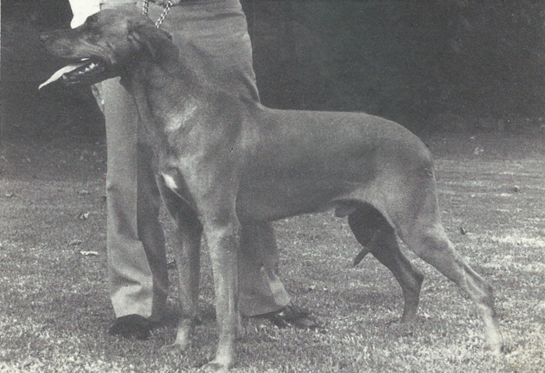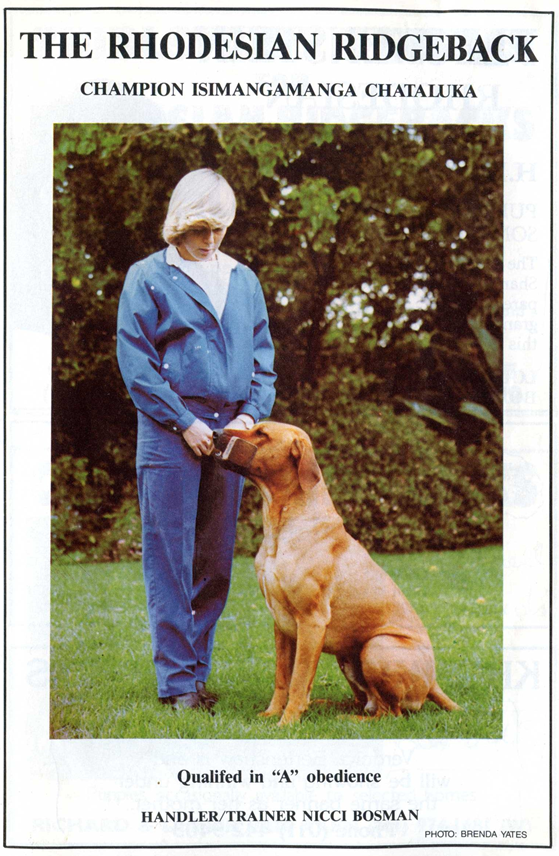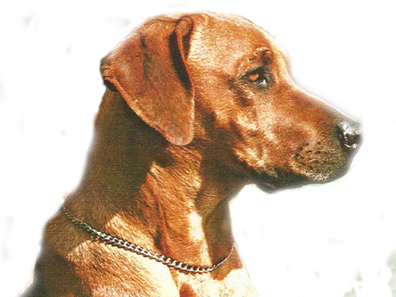Type in the Rhodesian Ridgeback
Liz Megginson
Some years ago I was researching an article for an American dog magazine, when I unearthed some letters, dated 1945, in which the correct type was disputed. Forty three years later at the recent Goldfields show I overheard two exhibitors arguing on the same subject, when a spectator put in his oar by saying that none of the four types shown in the ring that day even remotely resembled the Rhodesian Ridgeback that he had at home!
Type in the Rhodesian Ridgeback is what we the breeders have developed over the years but we each seem to have our own interpretation of the standard. I don’t believe the old story that the early settlers consciously and deliberately developed the Rhodesian Ridgeback as a breed. They were too concerned with their own day to day survival and most did not have the intelligence to plan breeding programmes or worry about type.
To understand type we must go back and, take a brief look at the history of the breed. From the time the Portugese Mariner, Bartholmew Diaz, discovered what later was to become the Cape of Good Hope, over a century had lapsed before South Africa was inhabited by white men. ln 1652, a settlement was founded by the Dutch East India Company and was, in the beginning, only meant to cater to the passing Dutch fleets by providing provisions and hospital facilities.
The person chosen to undertake this task was Jan van Riebeeck, who arrived on the 6 April, 1652 with his wife, one other lady and ninety men about whom he wrote in his diary: “They were weak, inept and scurvy ridden.”

Ch. Changara Likimba, the Megginsons’ current top winning dog
They had with them some supplies, but they eventually had to make friends and barter with the peaceful, primitive tribes of Hottentot cattle breeders in order to supplement their meat supply. Because this source was not always reliable, food supplies were short and, in addition, other produce was needed.
So soldiers, or free Burghers, as they were known, were released around 1657 to farm the Cape area. This started the tradition of farming in South Africa, where some of the original farms remain today (and on which it is almost just as traditional to keep a Ridgeback).
The “new” cattle farmers eventually occupied land East and North within an approximate 800 km radius of Cape Town.
Farms were large (around 3 000 hectares so voluntary’ labour was recruited from the Hottentots. Bushmen were a threat since they were Nomadic, owing few possesions, and no cattle, they soon became notorious cattle thieves. They were ignorant of, and did not understand civilisation.
They were simply killing for food and it is for all these reasons mentioned that I do not believe the theory that Bushmen dogs played a large part in the ancestry of our breed. True, doglike creatures appear on rock paintings and, after his travels in the Kalahari, Lawrence Green wrote in 1936 of a type of Bushman hunting dog, with a ridge, but this was twelve years after the first “Ridgeback” was registered with the Kennel Union.
White civilisation had progressed greatly by then and these dogs were most likely to have been cross-bred Boerhounds or Ridgebacks. The early figures depicted in rock paintings were possibly even dogs taken from the Hottentots during cattle raids. Because of their way of life, I cannot believe the Bushmen could have developed a particular breed.
While on the subject of theories, the other popular one is that the present day Ridgeback evolved from the ridged dogs on the island of Phu Quoc and was brought back to the Coast of Africa by Portugese sailors.
(12)

I am told that the Phu Quoc dogs are blue tongued and anyone with a knowledge of genetics will know that if this is correct, we can rule out the latter theory. The Hottentots had definitely developed their own breed, a small hyena-shaped dog with a ridge of hair growing forward on its back and an engraving of this can be seen in “Livingstone’s Missionary Travels in
South Africa”, published in 1857. It is often written that the Boer, by selective breeding, tried to develop a breed best suited to the conditions of South Afrim. But on reflection and thorough research, it is obvious that in the beginning this was not even so. One only has to page through the l92O’s and 30’s registrations to find that the most terribly incestuous breeding took place. Brother/sister and mother/son matings were common, although other dogs of different bloodlines were obviously available.
l believe that from the time the Hottentots moved onto the farms of the white man, taking with him his semi-wild Hottentot Hunting Dog, the dogs themselves were to dictate their own descendants and it was through initially “unplanned” inbreeding and the old story of the survival of the fittest, that of a definite type was evolved, which was best suited to the harsh conditions of South Africa. Very few dogs belonging to Europeans were “imported” into South African during the whole 18th century, another contributing factor in evolving a dominant strain.
The missionary, Reverend Charles Daniel Helm, did not realise it at the time, but he was to play an imporant role in the development of the breed in Rhodesia. Helm took a pair of ridged dogs with him on his journey to Matabeleland, but there is some discrepancy as to where this pair originated. lt is generally reported that they came from Swellendam, but Edmonds says he believes they were acquired at Oudshoorn. This could be well true, for in 1874 Helm travelled from Zuurbraak via Oudshoorn on his way North, whereas Swellendam was in the opposite directions It is perhaps also possible that he acquired the dogs in Kuruman, where he broke his journey, from January 1875 until October 1875.
Major Hawley quotes Jessie Lovemore as saying that her father (Helm) returned to Swellendam later for the dogs. But Dr Potgieter in his work says that he feels it was unlikely that Helm would have made that sort of journey so soon (within four years) after arriving at Hope Fountain mission stations I must agree with this, as I have found a missionary “log”, which records Helm’s movements. He does not appear to have left Hope Fountain from his time of arrival on December 12, 1875, until December 9, 1885, when he left for England on a two-year furlough. Helm was instrumental in taking the dogs into Rhodesia, but it was his friend and “guardian” of his dogs,
big game hunter Cornelius van Rooyen, who made the breed popular. He crossed Helm’s dogs with his own Great Danes to produce an exeellent and much prized hunting strain, which became known as “van Rooyen’s Lion Dogs”.
(14)
Mr F. Barnes, a great breeder of Pointers, arrived in Salibury just before the turn of the century and, shortly afterwards, he founded the Salisbury Kennel Club. He acquired a dog (Eskdale Dingo) from van Rooyen’s strain and so Barnes’ great interest in the breed began. He, more than anyone else, must take the credit for the birth of the breed as we know it today. For it was at his instigation, around 1922, that a meeting was held in Bulawayo to discuss the formation of a club.
Some time later, a number of dogs were brought together and a Mr Durham, an all-breeds judge, helped in selection of five dogs with desirable qualities, from which Barnes was able to draw up a standard, in an attempt to register the breed, although it was not until February 1926, that the South African Kennel Club accepted the Rhodesian Club’s affiliation and the name of the breed: Rhodesian Ridgeback (Lion Dog).
It was classified under the Gundog Group and was the only transferred to the Hound Group in 1949. Returning to the question of type, it must be noted that the true type of Rhodesian Ridgeback that Barnes had in mind was that of the Dalmatian. For years this fact was disputed and I have been involved in many heated arguments on the subject. But l now have in my possession, a copy of a letter which Barnes sent to Madel Weelings in 1954, in which he states: “ln drawing this (The Standard) up, l admittedly poached on the standard of the Dalmatian”.
Apart from the obvious differences, such as spotting, ridge, height and weight, if you place the two standards side by side, you will see that they are almost word for word. Looking at Dalmatians around the world, l have found them to be a very “typy” dog, so perhaps we should take a silhouette of the Dalmatian and keep it in mind when trying to breed our own true type.
Although Barnes once stated that he “hoped that the breed never developed into a purely exhibition specimen,” l feel that exhibiting is our only way to keep in touch with each other. The show ring is our shop window and should help us to eliminate any major deviation in type. It has been interesting to watch the return of Rhodesian Ridgeback breeders to the show ring after several years absence.
Their dogs are invariably a different type to those currently being shown, simply because they are “out of touch” and have had to rely on their own interpretation of the standard – a standard that is quite loosely worded and so has allowed for yet another type to be created. We must therefore not only keep in visual touch within out own countries, but from one country to another, if we are to develop a “world type”.
The Standard speaks for itself with regard to soundness and l do not intend to go into great detail here in that regard, but obvious faults are being ignored by uneducated judges. A dog with anything other than a strong level topline should never win, as a specimen of this kind would tire after a short time in the bush, just as a dog with a straight shoulder, causing stilted tiring -front movement tires easily. A dog with flat feet would have the same problem. Who is really to blame?
(15)
The judge with a set number of exhibits to rush through before lunch, or we the exhibitor, intent on boosting our ego, with another dog made up to champion status, regardless of type. We must start being honest with ourselves by eliminating from our breeding programmes those specimen which do not conform to the standard, including those “rare blues” which are creeping in and being developed and sold as the special “type” which they are not! We all know what the true type should look like, so it is time to stop turning a blind eye to the faults which we know exist in our own lines. There is an old English saying which could be applied to dog breeders throughout the world, “There’s none so blind as those who will not see!”
My last thought on the subject of type is that even if we achieve our goal of creating the perfect specimen, it will only be complete if it has strength and stamina to do the job for which it was bred.
l have been asked many times why l was drawn to the Ridgeback. I guess it was just part of those things African which l love and part of the lure of Africa which for some peculiar reason l have felt since early childhood. Then of course if one of this world’s most fascinating and brilliant men, (namely my idol Sir Laurens van der Post), saw fit to include in two of his books this breed which he had known and loved in Africa, then it had to be right for me.
I have also been asked to explain my luck in the show ring — it wasn’t luck, but careful and very selective breeding which can be achieved by anyone with dedication and determination, but with the best will in the world the ultimate goals will never be met, unless the right start is made.
Ridgebacks have a lot of hereditary problems, such as colour, hip dysplasia and the curse of the breed, the dermoid sinus, which occurs in the mid dorsal line and which can be very loosely described as an outer layer of skin and hair which forms a tube with a pin-point opening at the skin surface and continues downwards to varying depths, the most common being the one which attaches itself to the spine. Puppies with this defect should be culled at birth, but unfortunately there are those breeders who do not acquaint themselves with the problems of breeding and so this heartbreaking problem is often passed on to the unsuspecting puppy purchaser.
Detection of the dermoid sinus may be made by raising a fold of skin on the mid line of the back and by pressing one’s finger and thumb together through this fold, a tube, like a piece of thred can be felt. At the tiny opening to the skin’s surface a few darker hairs may protrude and if the sinus is attached to the spine, the surface of the skin will dimple when pulled up and away from the spine.
Before purchasing a Ridgeback puppy it is advisable to have it (and it’s background) checked by the breed club. lf your acquisition is a Rhodesian Ridgeback — Congratulations, you couldn’t have chosen better!
Megginson, L.(1988, October) Type in the Rhodesian Ridgeback.
Heads and Tails
